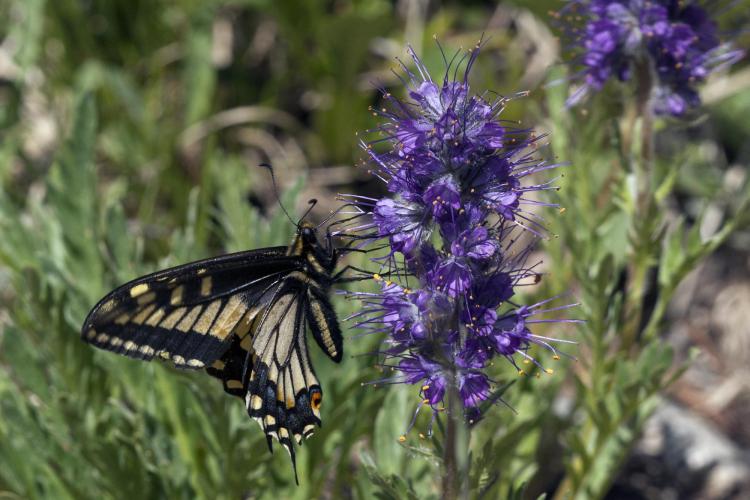Silky phacelia is a handsome wildflower with a special talent
Colorado's mountain wildflowers are famous for their beauty, and to my eye one of most handsome is silky phacelia, Phacelia sericea.
It is a long-lived perennial that sprouts each year from a woody base. From a cluster of hairy, basal leaves one to several flower stalks reach slightly more that a foot tall, with flowers arranged in vertical cylinders.
While silky phacelia attracts pollinators, and it is accumulating gold. Click here to see larger image. Photo by Jeff Mitton.
The pistils are within the floral cup, but the blue stamens and yellow anthers extend far beyond the petals, forming a colorful fringe around the cylinder of flowers. Silvery-blue hairs cover the leaves and stems, giving the plant a silky appearance.
Phacelia's most common pollinators are native bees, both solitary bees and bumblebees. I have also noticed butterflies visiting silky phacelia.
Here in the Front Range, silky phacelia does not form dense stands, but commonly occurs small clusters in the subalpine and alpine. However, it has an immense native range covering everything west of the Great Plains in North America, from New Mexico to Alaska. Within that range silky phacelia is also found in sagebrush shrublands and deserts.
Phacelia is a strongly cyanogenic plant, meaning that it can synthesize cyanide from amino acids and attach it to a sugar to form a glycoside, which it stores in leaves, stems and roots. If an herbivore takes a bite of a leaf and chews it, hydrogen cyanide, a lethal compound, is released. If the elk, deer, mouse, insect, snail or slug persists, it will soon die. A more likely scenario is that the animal will immediately sense that something is horribly wrong, spit, and never nibble that species again.
Approximately 500 plant species are known as hyperaccumulators, which are able to grow in soils with high concentrations of heavy metals. Their roots absorb metals, which are transported to leaves and stems and accumulated to concentrations 100 to 1,000 times higher than in the soil.
Most of the heavy metals are toxic at the concentrations found in hyperaccumulators, so the heavy metals repel herbivores. The metals employed by hyperaccumulators include arsenic, cobalt, selenium, molybdenum, zinc, nickel, mercury, iron, copper, cadmium and lead.
Phacelia is a hyperaccumulator, but it does not sequester any of the metals listed above. Silky phacelia hyperaccumulates gold.
Cyanogenic plants typically release some cyanide from their roots, and cyanide released into the soil can bind with gold, making it soluble. The gold cyanide can then be taken up by the plant and deposited in roots, stems and leaves, where its concentrations increase over time.
Silky phacelia has been noted to occur frequently on soils at and near gold mines. These soils are not the best for plants, for gold is usually associated with arsenic, a heavy metal toxic to many plant species. But phacelia tolerates arsenic, so these soils may exclude competitors, allowing phacelia to have larger, denser populations.
A study of several plant species at a gold mine in British Columbia measured concentrations of arsenic and gold in leaves, stems, roots and soil. Gold concentrations in phacelia's tissues were 10 to 100 times higher than in soil.
Elevated concentrations of virtually any of the heavy metals disrupt some aspect of metabolism or function in animals. But we think of gold as a noble, inert metal — you cannot have too much gold in the bank, but can you have too much gold in your body?
Data from gold treatments for aching joints and from people working in the gold plating industry demonstrate that elevated concentrations of gold damage both the liver and kidneys. I suspect that too much gold would have similar grave consequences for mammals such as deer, elk, mice and voles.
On soils containing gold, silky phacelia is protected by gold, cyanide and even some arsenic. On soils devoid of gold, it is protected by cyanide.
The study that found hyperaccumulation of gold in phacelia also found that yellow stonecrop, Sedum lanceolatum, accumulated gold, but to lower concentrations. I was aware that there was "gold in them thar hills," but I was not aware that pretty flowers collect gold.


